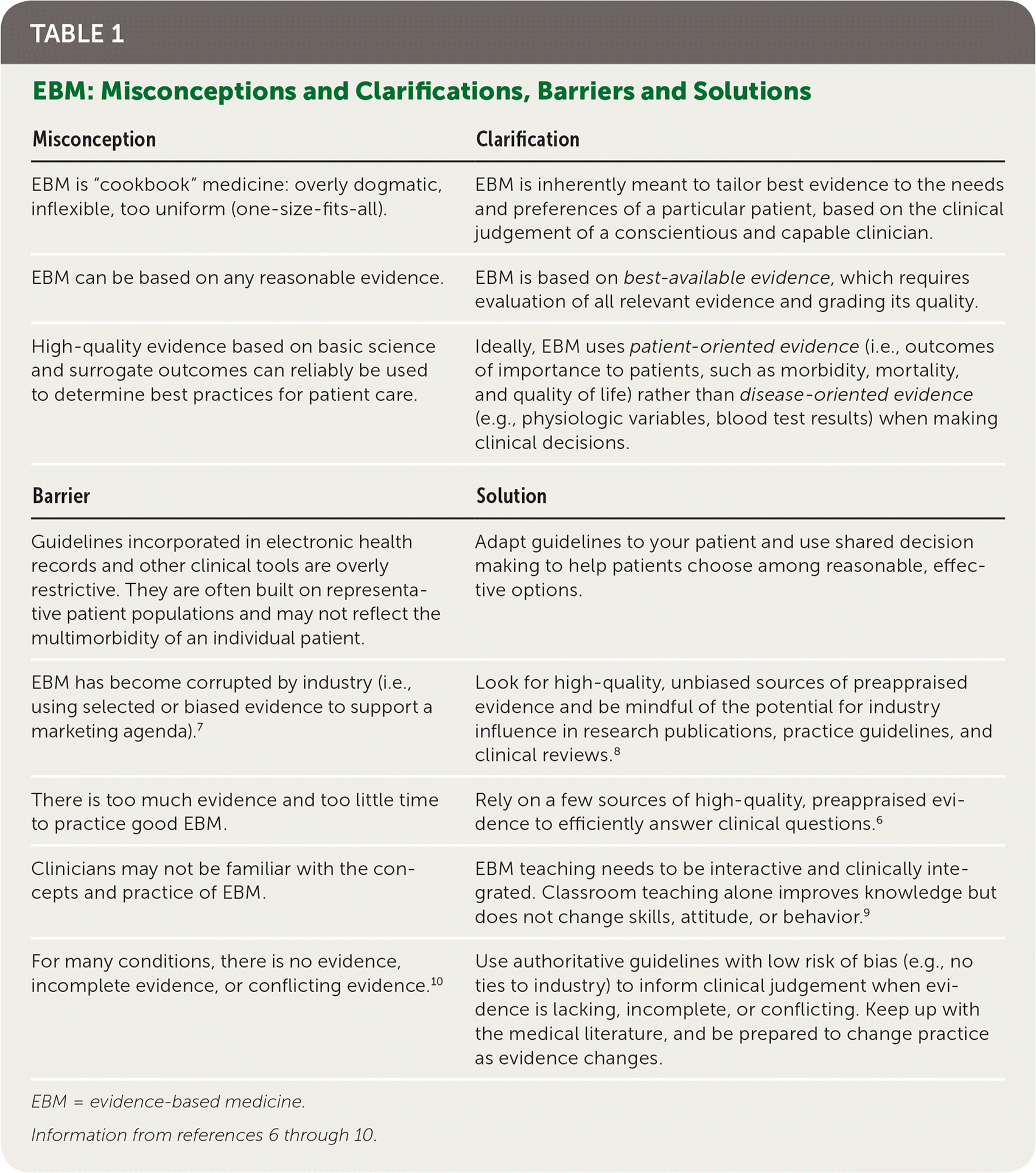
Am Fam Physician. 2018;98(6):343-344
Author disclosure: No relevant financial affiliations.
More than 25 years have passed since the term evidence-based medicine (EBM) was introduced into the medical literature.1 Its original definition has been expanded to include not only the quality of the evidence, but also the two key players applying the available evidence—namely the clinician and patient.2,3 A current working definition is: the integration of the best available evidence with clinical expertise and the individual patient's values, preferences, and unique circumstances.4 Despite the success of this approach, misconceptions and barriers remain5,6 (Table 16–10 ).

| Misconception | Clarification |
|---|---|
| EBM is “cookbook” medicine: overly dogmatic, inflexible, too uniform (one-size-fits-all). | EBM is inherently meant to tailor best evidence to the needs and preferences of a particular patient, based on the clinical judgement of a conscientious and capable clinician. |
| EBM can be based on any reasonable evidence. | EBM is based on best-available evidence, which requires evaluation of all relevant evidence and grading its quality. |
| High-quality evidence based on basic science and surrogate outcomes can reliably be used to determine best practices for patient care. | Ideally, EBM uses patient-oriented evidence (i.e., outcomes of importance to patients, such as morbidity, mortality, and quality of life) rather than disease-oriented evidence (e.g., physiologic variables, blood test results) when making clinical decisions. |
EBM is not dogmatic, “cookbook ” medicine.11 Instead, it relies on the expertise of a conscientious clinician in partnership with the patient. The clinician must navigate a sea of information and decide how best to apply it to the individual patient. And the patient—increasingly informed about all sorts of evidence—has the right and even responsibility to participate in shared decision making, especially for high-stakes decisions, values-driven decisions, and decisions in which there are several similarly effective options.10,12,13 Sometimes, patients knowingly decide against what the clinician believes is “best” and instead choose what is “best for them,” based on how they value specific benefits and harms.
Many clinicians mistakenly believe that applying some evidence is practicing EBM. That depends, however. What counts is basing clinical decisions on the best available evidence, not just any evidence. It also does not mean that we are paralyzed when good evidence to guide us is not available. We have all had the experience of seeing one randomized clinical trial contradicted by another.14 This is especially true when trials measure surrogate outcomes such as blood pressure or blood glucose level rather than patient-oriented outcomes, when study populations and interventions differ in important ways, or when trials have different levels of intentional or unintentional bias.
EBM requires the daunting task of evaluating all relevant evidence—something that clinicians in practice cannot be expected to do. That is why it is important to identify and use high-quality sources of preappraised evidence, for which a team of experts has done the heavy lifting, sorting through hundreds or even thousands of studies to produce systematic reviews and meta-analyses that synthesize the available evidence. Premier examples are the Cochrane Collaboration (https://www.cochrane.org/evidence) and the U.S. Preventive Services Task Force (https://www.uspreventiveservicestaskforce.org/). Then, look for sites that craft clinical guidance using these sources, such as DynaMed (http://www.dynamed.com; subscription required) and Essential Evidence Plus (http://www.essentialevidenceplus.com/; subscription required).
As noted earlier, beware of the pitfall of relying on surrogate outcomes, such as blood glucose measurements or other physiologic parameters. Instead, try to find patient-oriented evidence that shows improvements in morbidity, mortality, and quality of life. The Strength of Recommendation Taxonomy (SORT) evidence rating system used by American Family Physician (AFP) and other family medicine journals assigns higher grades to the latter. At AFP, we feature a collection of POEMs (patient-oriented evidence that matters; https://www.aafp.org/afp/poems) and each year publish the top 20 POEMs of the preceding year (https://www.aafp.org/journals/afp/authors/ebm-toolkit/resources/top-poems.html).
AFP also integrates the principles of EBM throughout its articles and features, such as Cochrane for Clinicians, FPIN's Clinical Inquiries and Help Desk Answers, Implementing AHRQ Effective Health Care Reviews, Medicine by the Numbers, Point-of-Care Guides, Putting Prevention into Practice, and STEPS: New Drug Reviews. Finally, we have an EBM Toolkit to aid in putting best evidence into practice (https://www.aafp.org/journals/afp/authors/ebm-toolkit.html). Let us know how we can make AFP an even better resource to help in the care of your patients, and improve the integration of EBM into clinical practice (e-mail: afpedit@aafp.org).15
Editor's Note: Dr. Siwek is Editor Emeritus for AFP.
